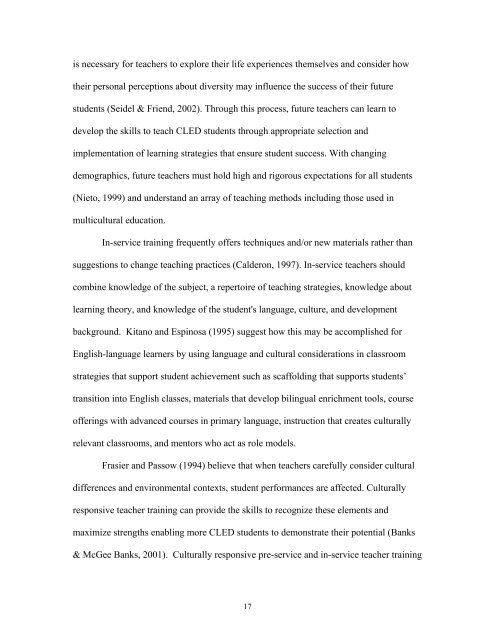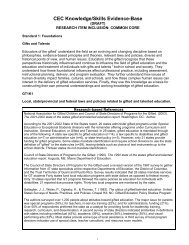Chapter One An Introduction to the Topic of Cultural Diversity - NAGC
Chapter One An Introduction to the Topic of Cultural Diversity - NAGC
Chapter One An Introduction to the Topic of Cultural Diversity - NAGC
Create successful ePaper yourself
Turn your PDF publications into a flip-book with our unique Google optimized e-Paper software.
is necessary for teachers <strong>to</strong> explore <strong>the</strong>ir life experiences <strong>the</strong>mselves and consider how<br />
<strong>the</strong>ir personal perceptions about diversity may influence <strong>the</strong> success <strong>of</strong> <strong>the</strong>ir future<br />
students (Seidel & Friend, 2002). Through this process, future teachers can learn <strong>to</strong><br />
develop <strong>the</strong> skills <strong>to</strong> teach CLED students through appropriate selection and<br />
implementation <strong>of</strong> learning strategies that ensure student success. With changing<br />
demographics, future teachers must hold high and rigorous expectations for all students<br />
(Nie<strong>to</strong>, 1999) and understand an array <strong>of</strong> teaching methods including those used in<br />
multicultural education.<br />
In-service training frequently <strong>of</strong>fers techniques and/or new materials ra<strong>the</strong>r than<br />
suggestions <strong>to</strong> change teaching practices (Calderon, 1997). In-service teachers should<br />
combine knowledge <strong>of</strong> <strong>the</strong> subject, a reper<strong>to</strong>ire <strong>of</strong> teaching strategies, knowledge about<br />
learning <strong>the</strong>ory, and knowledge <strong>of</strong> <strong>the</strong> student's language, culture, and development<br />
background. Kitano and Espinosa (1995) suggest how this may be accomplished for<br />
English-language learners by using language and cultural considerations in classroom<br />
strategies that support student achievement such as scaffolding that supports students’<br />
transition in<strong>to</strong> English classes, materials that develop bilingual enrichment <strong>to</strong>ols, course<br />
<strong>of</strong>ferings with advanced courses in primary language, instruction that creates culturally<br />
relevant classrooms, and men<strong>to</strong>rs who act as role models.<br />
Frasier and Passow (1994) believe that when teachers carefully consider cultural<br />
differences and environmental contexts, student performances are affected. <strong>Cultural</strong>ly<br />
responsive teacher training can provide <strong>the</strong> skills <strong>to</strong> recognize <strong>the</strong>se elements and<br />
maximize strengths enabling more CLED students <strong>to</strong> demonstrate <strong>the</strong>ir potential (Banks<br />
& McGee Banks, 2001). <strong>Cultural</strong>ly responsive pre-service and in-service teacher training<br />
17

















